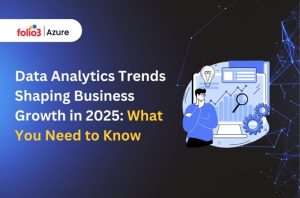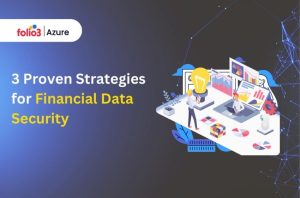Table of Contents
ToggleIt is becoming challenging for organizational leaders to choose between business intelligence for operational clarity or business analytics for predictive advantage. Most organizations deploy both technologies without understanding their distinct strategic purposes, leading to redundant investments and suboptimal returns.
As per the research, 75% of organizations are now running cloud-delivered business intelligence and analytics solutions. However, the critical question isn’t whether to adopt these technologies; it’s how to deploy them strategically to solve specific data challenges.
In this blog, we’ll decode the business intelligence vs business analytics distinction that determines your business’s success in solving data challenges.
What is Business Intelligence and Business Analytics?
Business Intelligence: Operational Performance Management
Business intelligence transforms organizational data from ERP systems, CRM platforms, and operational databases into standardized reports and dashboards. BI answers “what happened” and “what’s happening now” through descriptive analytics that track KPIs, monitor compliance, and measure performance against targets.
Core BI capabilities include data warehousing, automated reporting, real-time dashboards, and analytics tools. The technology focuses on structured data processing with intuitive data visualization interfaces that enable business users to access insights without technical expertise.
BI operates reactively, identifying problems after they occur and providing historical context for tactical decisions. It optimizes current operations but doesn’t predict future outcomes.
Business Analytics: Predictive Strategy Development
Business analytics uses statistical modeling, machine learning, and advanced algorithms to predict future scenarios and prescribe optimal actions. Analytics answers “what will happen” and “what should we do” through predictive and prescriptive models that forecast trends, identify opportunities, and recommend strategies.
This approach requires sophisticated data modeling and reporting capabilities, statistical computing platforms, and data science expertise to process both structured and unstructured data sources. Analytics generates forward-looking intelligence that drives strategic decision-making and competitive positioning.
Where BI reports current customer churn rates, analytics predicts which specific customers will churn next quarter and recommends retention interventions most likely to succeed.
Difference Between Business Intelligence and Business Analytics
Understanding the difference between business intelligence and business analytics comes down to how each impacts your strategic capabilities.
1. Time Focus and Strategic Impact
Business intelligence optimizes current operations. When manufacturing dashboards show Equipment Line B running 18% below efficiency targets, operations managers can investigate training issues, maintenance schedules, or equipment problems immediately.
Business analytics drives strategic positioning. Predictive algorithms analyzing sensor data from that same equipment line forecast failure probability six weeks ahead, enabling scheduled maintenance that prevents costly emergency shutdowns.
2. Data Complexity and Integration
BI solutions work well with existing structured data from ERP systems, CRM platforms, and financial databases. This information is already organized and relatively clean, making BI implementation straightforward.
Business analytics requires integrating diverse data sources. Accurate customer lifetime value predictions need transaction histories, web behavior, support interactions, social engagement, competitive intelligence, and economic indicators. This demands sophisticated data engineering capabilities.
3. Organizational Requirements
Business intelligence fits existing organizational structures. Finance teams build variance reports, operations managers track KPIs, and sales leadership monitors pipelines using intuitive interfaces that don’t require technical training.
Business analytics demands new skill sets. Effective predictive modeling needs data scientists who understand both advanced statistics and business context. You’re building analytical capabilities, not just installing software.
4. Return Timelines
BI implementations show value quickly. Better reporting saves time, faster metric access improves decision speed, and consistent data definitions eliminate conflicting analyses. Most organizations see positive ROI within six months.
Analytics programs need longer development cycles but generate transformational returns. Customer segmentation models or demand forecasting systems take time to build, but competitive advantages, higher conversion rates, optimized inventory, and improved pricing compound annually.
Real-World Problem Solving
Understanding what business intelligence and analytics are becomes clearer through actual industry applications.
1. Manufacturing Operations
Manufacturing facilities generate enormous data volumes from sensors, quality systems, maintenance logs, and supply tracking. BI transforms this into operational intelligence: real-time equipment performance, quality trends, inventory status, and schedule adherence.
For instance, one automotive manufacturer reduced unplanned downtime by 35% using predictive maintenance and cut maintenance costs by 25-30%, saving millions annually.
2. Customer Intelligence
Traditional customer analysis relies on demographic segments and purchase histories. BI provides comprehensive dashboards showing revenue by segment, product preferences, geographic distribution, and satisfaction scores.
For instance, E-commerce companies using sophisticated customer analytics report 15-25% conversion rate increases and 20-30% retention improvements versus organizations using only traditional BI.
3. Financial Risk Management
Financial services have always been data-intensive, but regulatory requirements and competitive pressures demand more sophisticated risk approaches.
BI delivers essential regulatory reporting, portfolio monitoring, and operational risk tracking. Compliance dashboards ensure adherence to capital requirements, lending standards, and consumer protection regulations.
Analytics enables proactive risk management. Credit models evaluate default probability using hundreds of variables, including financial data, alternative sources, and behavioral patterns. Fraud detection identifies suspicious transactions in real-time while minimizing false positives, frustrating legitimate customers.
Investment Returns and Measurement
ROI analysis requires different metrics for business intelligence vs business analytics initiatives.
BI Returns
Business intelligence investments demonstrate value through operational efficiency. Automated reporting eliminates manual compilation, saving hundreds of hours monthly. Faster metric access enables quicker problem response, reducing revenue impact.
Most BI implementations achieve positive ROI within 6-12 months, with benefits compounding as usage expands across departments.
Analytics Value
Analytics requires longer development but generates transformational returns. Customer models improving retention by just 5% can increase profits 25-95% depending on industry dynamics. Supply chain optimization, reducing inventory by 10% while maintaining service levels, provides immediate working capital improvements.
Revenue optimization represents the highest-value applications. Dynamic pricing algorithms optimizing margins based on demand, competition, and customer sensitivity can increase profitability 2-7%. For large organizations, this means millions in additional annual profit.
Strategic Decision Framework to Decode Data Challenges
The difference between business intelligence and business analytics isn’t about choosing one approach; it’s about sequencing investments based on organizational needs and capabilities.
BI-First Implementation Strategy
Organizations should prioritize business intelligence analytics when foundational data infrastructure is lacking. Key indicators include managers requiring IT assistance for basic performance metrics, inconsistent data definitions across departments, and manual regulatory reporting processes. These gaps signal that operational visibility must be established before predictive capabilities can deliver value.
BI-first strategies work best for organizations focused on optimizing current operations, improving decision-making speed, and establishing data governance frameworks that support future analytics initiatives.
Analytics-Forward Implementation Strategy
Analytics-first approaches suit organizations operating in markets where predictive insights create competitive differentiation. Industries like technology, financial services, and retail often benefit from this strategy, particularly when rich data sources beyond transactional systems are available and analytical talent can be recruited or developed.
Success requires leadership understanding of statistical concepts and organizational commitment to longer development cycles. Analytics investments typically require 12-18 months to demonstrate full value but generate transformational returns through improved customer intelligence, operational optimization, and strategic positioning.
Enterprise-Scale Hybrid Approaches
Large enterprises frequently develop BI and analytics capabilities simultaneously across different business units. Operations teams require current performance visibility while strategic planning functions need predictive intelligence. This parallel approach accommodates varying analytical maturity levels across organizational functions.
Effective hybrid implementations establish center of excellence models providing shared expertise while enabling business unit customization. Clear governance frameworks prevent duplicate investments while ensuring analytical consistency and data quality standards across the enterprise.
Technology Infrastructure Evolution
The business intelligence and business analytics technology landscape has transformed dramatically with cloud platforms and AI capabilities.
Modern BI Capabilities
Today’s BI emphasizes self-service functionality and rapid deployment. Microsoft Power BI integrates seamlessly with Office 365 and Azure services, appealing to organizations already using Microsoft ecosystems. Tableau continues to lead visualization innovation with intuitive interfaces enabling complex analysis without programming.
Cloud-native platforms like Looker and Power BI provide modern architectures designed for distributed teams and real-time sources. These eliminate traditional infrastructure constraints while delivering enterprise performance and security.
Microsoft has further evolved this landscape with Microsoft Fabric, an all-in-one analytics platform that unifies data integration, data science, real-time analytics, and business intelligence in a single Software-as-a-Service (SaaS) solution. Fabric brings together familiar tools like Power BI, Azure Data Factory, and Azure Synapse Analytics into a cohesive platform, eliminating the complexity of managing multiple disconnected services while providing automatic scaling and simplified administration.
Advanced Analytics Infrastructure
Analytics demands more sophisticated foundations. Cloud data platforms like Snowflake and Databricks provide computational power and storage flexibility for machine learning workloads. These automatically scale resources based on analytical demands while controlling costs.
AI services from Azure democratize advanced analytics through pre-built algorithms and automated model development. Organizations can implement sophisticated predictions without building data science teams internally.
Integration Considerations
Successful implementations require robust data governance. Master data management ensures consistent definitions across systems. Data lineage maintains audit trails for compliance. Security controls protect sensitive information while enabling appropriate analytical access.
Modern platforms support hybrid architectures integrating on-premises systems with cloud analytics services. This addresses security concerns while providing scalability and capabilities unavailable in traditional infrastructure.
Conclusion
The business intelligence vs business analytics choice depends entirely on your current capabilities and strategic objectives. BI provides operational foundations for informed decisions, while analytics creates predictive advantages for market leadership.
At Folio3, we build integrated data ecosystems matching your specific requirements. As a certified Microsoft Partner, we specialize in data integration, Power BI customization, and advanced analytics that transform operational data into strategic intelligence.
Whether establishing foundational BI capabilities or advancing toward predictive analytics, Folio3 delivers solutions bridging operational reporting and strategic insights for measurable growth and sustainable competitive advantage.
Ready to solve your data challenges? Connect with our experts to accelerate your data-driven decision-making.



